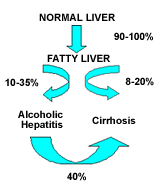
Alcoholic Hepatitis
Alcoholic Hepatitis
B. J. Johnson
Excessive alcohol consumption is the third-leading preventable cause of death in the United States. Alcohol-associated mortality is disproportionately high among young people, and approximately 30 years of life are lost per alcohol-associated death – or in the aggregate, 2.3 million years of potential life lost in 2001 in the United States.
Excess consumption of alcohol is associated with both short-term and long-term liver damage several types of cancer, unintentional injuries both in the workplace and on the road, domestic and social violence, broken marriages, and damaged social and family relationships.
The association between alcohol intake and alcoholic liver disease has been well documented, although cirrhosis of the liver develops in only a small proportion of heavy drinkers. The risk of cirrhosis increases proportionally with consumption of more than 30 g of alcohol per day; the highest risk is associated with consumption of more than 120 g per day. It is presumed that other factors, such as sex, genetic characteristics, and environmental influences (including chronic viral infection) play a role in the genesis of alcoholic liver disease.
Chronic alcohol use may cause several types of liver injury. Regular alcohol use, even for just a few days, can result in a fatty liver (also called steatosis), a disorder in which hepatocytes contain macrovesicular droplets of triglycerides. Although alcoholic fatty liver resolves with abtinence, steatosis predisposes people who continue to drink to hepatic fibrosis and cirrhosis. This review focuses on alcoholic hepatitis, a treatable form of alcoholic liver disease. Since up to 40% of patients with severe alcoholic hepatitis die within 6 months after the onset of the clinical syndrome, appropriate diagnosis and treatment are essential.
Alcoholic hepatitis is a clinical syndrome of jaundice and liver failure that generally occurs after decades of heavy alcohol use (mean intake, approximately 100 g per day. Not uncommonly, the patient will have ceased alcohol consumption several weeks before the onset of symptoms. The typical age at presentation is 40 to 60 years. Although female sex is an independent risk factor for alcoholic hepatitis,.more men drink to excess, and there are more men than women with alcoholic liver disease. The type of alcohol consumed does not appear to affect the risk of alcoholic hepatitis.
The cardinal sign of alcoholic hepatitis is the rapid onset of jaundice. Other common signs and symptoms include fever, ascites, and proximal muscle loss. Patients with severe alcoholic hepatitis may have encephalopathy. Typically, the liver is enlarged and tender.
Recovery from alcoholic hepatitis is dictated largely by abstinence from alcohol, the presence of a mild clinical syndrome, and the implementation of appropriate treatment. Within several weeks after discontinuation of alcohol intake, jaundice and fever may resolve,m but ascites and hepatic encephalopathy may persist for months to years. Either continued jaundice or the onset of renal failure signifies a poor prognosis. Unfortunately, even when patients adhere to all aspects of medical management, recovery is not guaranteed.
The differential diagnosis of alcoholic hepatitis inclues nonalcoholic steatohepatitis, acute or chronic viral hepatitis, drug-induced liver injury, fulminant Wilson’s disease, autoimmune liver disease, alpha-1 antitrypsin deficiency, pyogenic hepatic abscess, ascending cholangitis and decompensation associated with hepatocellular carcinoma.
The findings on liver biopsy may confirm the features described above and may help rule out other causes of liver disease, but a biopsy is not required to make the diagnosis. The risk of bleeding during or after the biopsy can be reduced with the use fo the transjugular route. A liver biopsy is not recommended to confirm or refute abstinence,m since it is difficult to asses the timeline of the resolution of the histologic features.
Some patients with alcoholic hepatitis will become candidates for liver transplantation. The MELD score, which is based on a numberical scale, predicts a patient’s risk of death while waiting for a liver transplant; the score is based on serum levels of bilirubin and creatanine and the INR.
B.J. Johnson, RPR, CPE, is a reporter in Reno, NV.